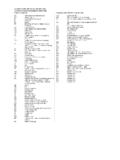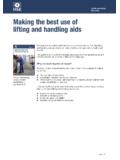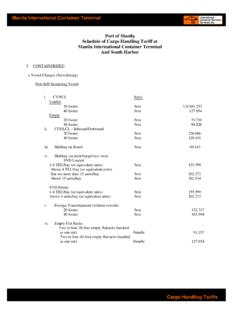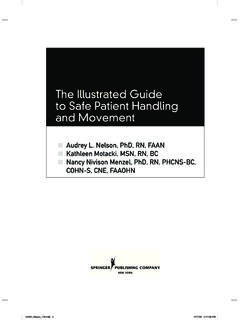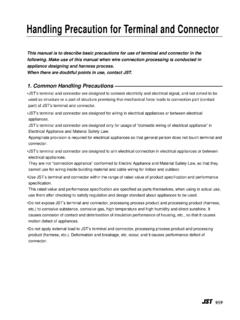Transcription of An investigation into the use of plasterboard manual ...
1 Prepared by the Health and Safety Laboratory for the Health and Safety Executive 2010 Health and Safety ExecutiveAn investigation into the use of plasterboard manual handling aids in the GB construction industry and factors helping and hindering the practicability of their applicationRR812 Research ReportTony Wynn Health and Safety LaboratoryHarpur HillBuxtonDerbyshireSK17 9 JNThere is clear potential for risk of musculoskeletal injury when lifting and handling panel products such as plasterboard ; and dry-lining operatives have been shown to have one of the highest prevalence rates for musculoskeletal disorders (MSD) in the construction industry. These problems are common because many of the materials they handle are heavy, and require the adoption of awkward postures (ie bending and twisting) when lifting.
2 The introduction of ergonomic improvements may reduce physical load and the incidence of sickness absence. However, despite the existence of mechanical lifting devices for handling and assisting with the installation of plasterboard , there is reservation within the industry as to how practicable such solutions are in terms of their real world application. The purpose of this report is to investigate the manual handling and work related risk factors for MSD associated with the installation of plasterboard , and to evaluate the impact of manual handling aids in terms of risk reduction and the time taken to install plasterboard . This report and the work it describes were funded by the Health and Safety Executive (HSE). Its contents, including any opinions and/or conclusions expressed, are those of the author alone and do not necessarily reflect HSE investigation into the use of plasterboard manual handling aids in the GB construction industry and factors helping and hindering the practicability of their applicationHSE BooksHealth and Safety Executive Crown copyright 2010 First published 2010 All rights reserved.
3 No part of this publication may be reproduced, stored in a retrieval system, or transmitted in any form or by any means (electronic, mechanical, photocopying, recording or otherwise) without the prior written permission of the copyright for reproduction should be made in writing to:Licensing Division, Her Majesty s Stationery Office,St Clements House, 2-16 Colegate, Norwich NR3 1 BQor by e-mail to ACKNOWLEDGEMENTS The author would like to thank the construction companies and trade associations, who assisted at various stages of this project, for their time and positive attitude during this research.
4 In particular (in alphabetical order): Association of Interior Specialists AT Jones & Son Ltd Bellway Plc British Gypsum Builders Merchants Association Federation of Plastering and Drywall Contractors (FPDC) Gypsum Products Development Association (GPDA) Home Builders Federation Knauf UK Lafarge London Drywall Ltd McClaren Construction Ltd Miller Homes Ltd Morgan Lovell National Association of shop fitters Overbury Powells Ltd Speedy Lifting Ltd The BDL Group Plc The UK Contractors Group Vladar Ltd WACO UK Ltd Wates Living space iiiiv CONTENTS 1 1 2 AIMS AND 2 2 2 3 METHODS.
5 3 Data collection .. 3 Data analysis .. 4 4 LITERATURE REVIEW .. 5 plasterboard 5 Physical demands and the prevalence of musculoskeletal injury .. 7 Controls for ergonomic risk factors .. 11 5 ASSESSMENT .. 14 manual handling risk factors .. 14 Loading 17 Measuring and cutting plasterboard .. 27 LIfting and handling plasterboard .. 32 Ceiling 36 Time 46 Informal 47 Summary and 6 RECOMMENDATIONS FOR RISK REDUCTION .. 51 7 51 vvi EXECUTIVE SUMMARY manual handling of plasterboards in order to construct interior building walls and ceilings is a risk factor for musculoskeletal complaints (van der Molen et al.)
6 , 2007) and plasterers have been shown to have one of the highest prevalence rates for musculoskeletal disorders (MSD) in the construction industry (Reid et al., 2001). MSD are caused by many factors, including awkward postures ( bending, stretching, twisting), repetitive movements, using force and manual handling (lifting and carrying) and these activities are recognised as a regular component of plasterers work (Chiou et al., 1997; Lipscomb et al., 1997; Pan and Chiou, 1999; Smallwood et al., 2006). They can occur in any part of the body, but are particularly common in the lower back, neck, shoulders, elbows, wrists and hands. Furthermore, repeated bending or standing for long periods, particularly on uneven surfaces, can lead to discomfort in the legs, knees and feet (van der Molen et al.
7 , 2007). These problems are common in plasterers because, many of the materials they handle are heavy, and often require the adoption of awkward postures ( bending and twisting) when lifting and fitting panels (Cowley and Leggett, 2003; Reid et al., 2001). Despite the existence of mechanical lifting devices for handling and assisting with the installation of plasterboard , there is reservation within the construction industry as to how practicable such solutions are in terms of their real world application (van der Molen et al., 2007). The aim of this research is to investigate the manual handling and work related risk factors for MSD associated with the installation of plasterboard and to evaluate the impact of manual handling aids, in terms of risk reduction and the time taken to install plasterboard .
8 Objectives In order to achieve the aims of this project the following objectives are identified: 1. Undertake a literature review of manual handling and musculoskeletal injuries and ill health in the plasterboard installation industry; 2. Undertake site visits of the proposed scenarios ( using handling aids versus not using handling aids in housing and commercial construction); 3. Identify from the site visits the manual handling and work environment risk factors when installing plasterboard in the different scenarios; 4. Identify from the site visits the manual handling aids used during plasterboard handling and installation and make comparisons of the time taken to install the plasterboard when using handling aids or when not using them.
9 Main Findings handling and installing plasterboard represents a moderate to high level of MSD risk. This is predominantly due to the weight and unwieldy nature of the plasterboard . The handling and installation tasks are highly repetitive and awkward postures ( bent forward, trunk twisting and reaching with the hands above shoulder height) can be adopted. For example, when installing plasterboard on ceilings and walls, when lifting plasterboard up onto scaffolding and when measuring and cutting it. Fixing plasterboard to the ceiling exposes individuals to a higher MSD risk compared to fixing to walls. This is due to the static nature of the activity when holding the plasterboard in position overhead and the repetitive hammering or use of a power drill above shoulder height with the neck hyper-extended.
10 Individuals will be most at risk from lower back injury due to the frequent handling of the plasterboard . The risk of neck injury is likely to be increased due to the hyperextension required when installing plasterboards to ceilings. The shoulders and upper limbs are also likely to be at an increased risk of developing a vii MSD, due to the repetitive use of power tools, particularly at or above shoulder height. The observed manual handling aids (ceiling lift and adjustable support prop) reduce the risk of MSD associated with installing ceilings from high to moderate/low risk.










